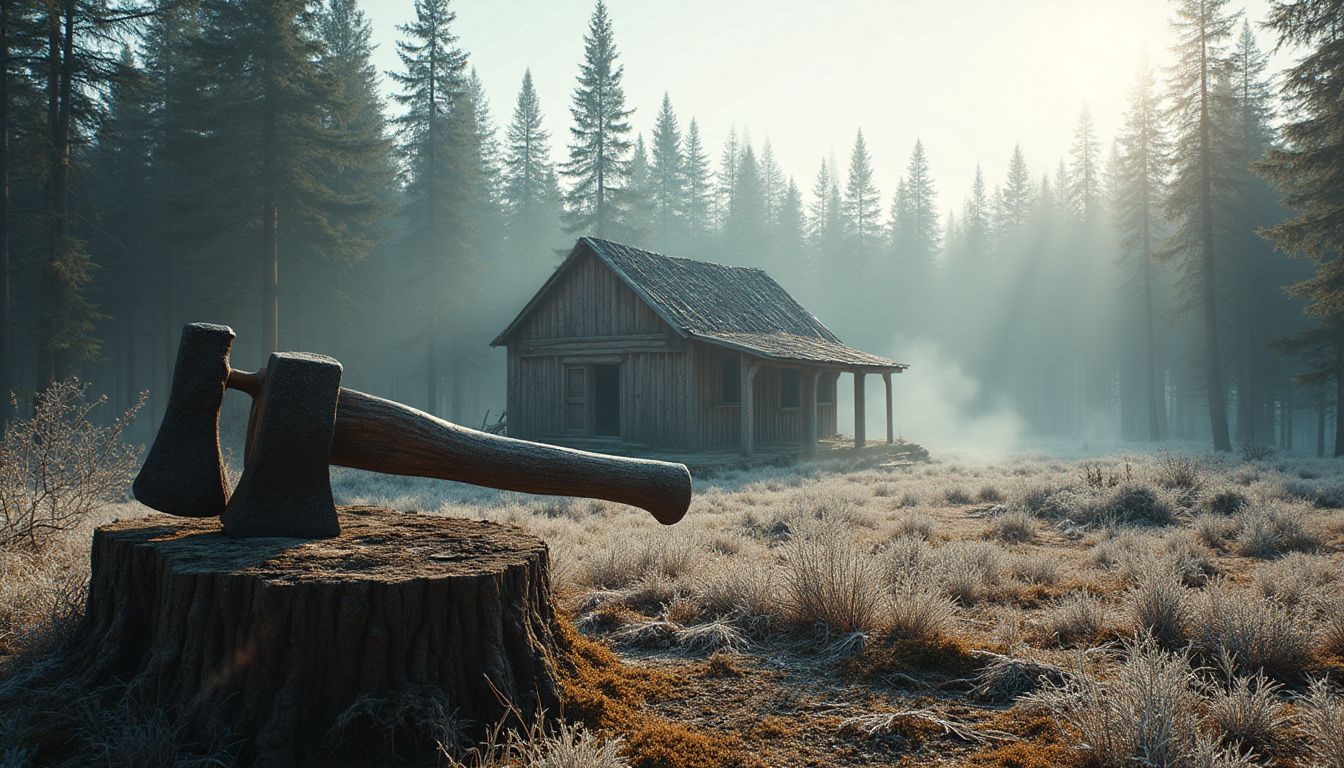Story
The axe sang through the forest air, landing into spruce with a meaty thud. Each swing echoed in the silence like a primal mantra. Lucien Caron, tall and sinewy with a shock of black hair tied back in a leather thong, paused and wiped the sweat from his brow with the edge of his ivory-colored tunic. The wool was worn smooth at the cuffs and collar, a remnant of a time before the Northern Collapse, before the world lost its blueprint for civilization.
The tree groaned, tilted, and fell to the thud of its own obituary. Lucien closed his eyes as the pine hit the frozen earth, inhaling the sharp scent of sap as if it were incense. Somewhere, deep in the marrow of his bones, he understood that building mattered. Not surviving — not anymore — but building something that curve-bent entropy.
He hung his axe beside the beatskin pack slung over the yoke log and began measuring the fallen trunk with a strip of parched sinew knotted at inches. Across from him, a skeletal wooden frame rose against the tree line, the half-born ribcage of a dwelling. Mortise and tenon joints stitched together with hand-carved dowels lashed with sinew — all aligned with obsessive detail. He'd cut no corners. This was more than shelter.
Atop the slope, the ruins of the commune still wept smoke. The 'FedTech bidomes' that once promised that tech and nature could coexist now lay shattered, glass like fallen stars in the mud. It had looked promising — silicon solar veins running over timber nerves, artificial joints replicating ancient Japanese joinery. But machines were optimized for utility, not intuition. When the corrosion came, the code lagged behind the rot.
Lucien had warned them. But architects mocked carpenters in that world, especially the kind who read treatises older than electricity and carved dovetail joints by candlelight. So he’d left. Again. Like he always did.
And then they came calling. Or rather, crawling.
Three weeks ago, Pascal — the last surviving tech tinkerer of Camp Arctia — trekked through radioactive fog and twisted birch for three days straight to find Lucien. He brought with him salvaged motherboards, a solar amplifier, and the diary of Mira, Lucien's late lover — along with a last wish scribbled in the margin. “Build something that can’t forget me.”
Lucien told himself he didn't believe in ghosts. But who else traced her scent through the wood shavings at night?
Now, as dusk drifted down like marsh smoke, Lucien carved the joining tenon on a support beam using only the light of phosphorescent moss stitched into waxed cloth, just as old French joiners once used mirrors and moonlight. The tenon was perfect. He aligned it with its waiting mortise, wedged it snug, and tapped it flush with a maul made of antler and ash.
Then, for the first time since the Commune fell, he smiled.
He reached inside the beatpack, pulled out a relic — her necklace, cherrywood and ivory, knotted into a loop of old-line code etched in rune-script, and placed it above the entry join. As the downward sun ignited the rim of the forest in molten amber, the necklace caught the light—and glowed faintly, whispering a stored memory in her voice: “You always said tight joints made permanence. Make one for me.”
He stepped back. The house — her house — stood. Not finished, but no longer an idea.
An ember in the wilderness. A joint of permanence. And memory, now immortal in timber.
Sometimes architecture remembers what we forget — the hands behind the home, and the love in every alignment.
Genre: Post-apocalyptic / Magical Realism
The Source...check out the great article that inspired this amazing short story: The Beginner’s Guide to Woodworking Joinery
Disclaimer: This article may contain affiliate links. If you click on these links and make a purchase, we may receive a commission at no additional cost to you. Our recommendations and reviews are always independent and objective, aiming to provide you with the best information and resources.
Get Exclusive Stories, Photos, Art & Offers - Subscribe Today!

























Post Comment
You must be logged in to post a comment.